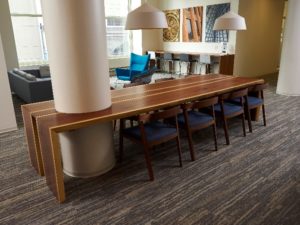By Scott Lyon, Forest Products Specialist
Many communities have expressed greater interest in local goods and services over the last few years; as a result, urban wood recycling efforts have increased in Wisconsin. The increase of trees killed by invasive insects and disease caused many municipalities to seek alternative uses for urban wood rather than disposing material in a landfill. Recent efforts to market this growing source of material and develop ways to recycle urban trees within communities led Wisconsin to become one of the leading states in urban wood utilization.

Live edge walnut slab table at a Milwaukee based business.
Throughout the state, markets have started to grow; at least 30 companies are producing products made from urban wood. The City of Milwaukee cut their disposal costs in half by sending their street tree removals to Kettle Moraine Hardwoods and Bay View Lumber. Consumers are drawn to urban wood for its unique character appearance that enhances its use in furniture, cabinets, flooring, millwork, wall and ceiling panels. Urban wood can now be found in large scale projects such as ceiling and wall panels at the new Milwaukee Bucks Arena, and apartment and business buildings in Milwaukee. In both Milwaukee and Madison, the hobbyist wood worker can find urban wood lumber and live edge slabs at the local Habitat for Humanity Restore. Urban wood manufacturers have noted an increase in demand for live edge slabs for use in tables, desks and countertops.
Demand for urban wood has increased not only in Milwaukee and Madison, but across the state in other communities such as Green Bay, Appleton, and Eau Claire. In Eau Claire, urban wood is making some noise (literally) after repurposing in the manufacture of guitars. In addition, the City of Eau Claire has partnered with some Wisconsin Urban Wood members to produce furniture and specialty products. Wisconsin Urban Wood is the brand that assures consumers that the wood originated from Wisconsin’s community forests and passed through an entire supply of Wisconsin-based business to arrive as the final product.
However, a need still exists to help end-consumers and other users, such architects, interior designers, and engineers, understand the benefits and value of using wood and overcome perceived barriers. Wood is a renewable resource as opposed to substitute non-renewable products such as concrete, steel, and plastics.
For more information on urban wood use or to find an urban wood user in your area please visit Wisconsin Urban Wood or the Urban Wood Network.
